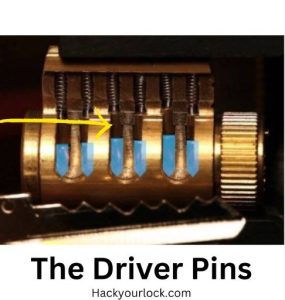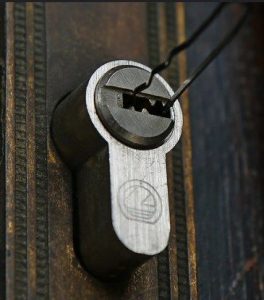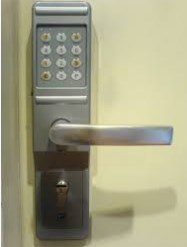Anti-pick locks are special kinds of locks designed to be really tough for lock pickers to open without the right key. Locks are meant to keep things safe and secure.
Imagine if anyone could easily pick a lock and get into your home or office. That wouldn’t be very safe, right? So, it is important to have anti-pick locks in your possession.
The purpose of these anti-pick mechanisms is to make it super tricky for lock pickers to do their thing and keep your stuff safe. But how do anti pick locks work? Let’s find out!

Contents
- 1 How Do Anti Pick Locks Work?
- 2 Basic Lock Components
- 3 Lock Picking Techniques
- 4 Anti-Pick Features: How Do Anti Pick Locks Work Their Magic
- 5 Bump Resistance: Keeping Your Locks Safe from Sneaky Bumping
- 6 Picking Resistance Ratings: How to Choose a Secure Lock
- 7 Electronic Anti-Pick Measures: Protecting Your Digital Locks
- 8 Locksmith and Manufacturer Perspectives
- 9 Conclusion
- 10 FAQs
- 11 Resources
How Do Anti Pick Locks Work?
Anti-pick locks work by having special features inside them that make it really hard for lock pickers to open them without the correct key. Anti-pick locks work with their unique features, like tricky pins and tumblers that are difficult to manipulate with lock-picking tools.
They might also have complex keyways that make it tough for lock pickers to access the pins. Some anti-pick locks even use special pins called spool pins or mushroom pins that are harder to pick. These features come together, making it possible for anti-pick locks to work and challenge anyone to pick the lock without the right key.
Basic Lock Components
When it comes to understanding how do anti pick locks work, it’s essential to start with the basics. These locks consist of several key components, each playing a crucial role in their security.
Understanding how anti-pick locks work involves grasping the role of these basic components: the cylinder and key, the pins and tumblers, and the keyway. Together, they create a secure barrier that deters even the most determined lock pickers.
A. Cylinder and Key

Think of the cylinder as the heart of the lock and the key as the magic wand that makes it open. The cylinder is the part where you insert the key, and it’s where all the action happens.
When you turn the key, it interacts with the cylinder’s inner workings, allowing you to lock or unlock the door.
B. Pins and Tumblers

Inside the cylinder, you’ll find a set of pins and tumblers. These tiny components are what make anti-pick locks so secure. When you insert the key, it pushes these pins and tumblers into specific positions.

Only when they’re aligned perfectly can you turn the key and open the lock.
Now, here’s where the “anti-pick” magic happens.
Lock pickers try to manipulate these pins and tumblers to open the lock without the right key. But anti-pick locks make this incredibly tricky.
They use special pins and tumblers that are challenging to pick, making it hard for even skilled lock pickers to succeed.
C. Keyway

The keyway is the pathway that the key travels through when you insert it into the lock. It’s like a maze that guides the key to the right spot.
Anti-pick locks often have unique and complex keyways that add an extra layer of security. These unusual shapes and designs make it difficult for lock pickers to navigate the keyway and manipulate the pins and tumblers.
How do anti pick locks work requires a detailed explanation but knowing lock picking techniques before answering this query is very important.
Lock Picking Techniques
Lock picking is a craft that involves trying to manipulate the inner components of a lock to open it without the proper key. Lock pickers use various tools and techniques to achieve this, and it’s more challenging than it looks in movies! They often try to mimic the key’s action by adjusting pins and tumblers inside the lock.
A. Traditional Lock Vulnerabilities
Traditional locks, while effective to some extent, have vulnerabilities that lock pickers exploit. These locks typically have pins and tumblers that, if not well-protected, can be nudged into the right positions by a skilled lock picker. This is where anti-pick locks come into play and you get to know how do anti pick locks work.
B. Importance of Resisting Picking
Now, here’s the key to the whole puzzle: anti-pick locks. These locks are designed to withstand lock picking attempts. They do this by incorporating clever mechanisms that make it incredibly hard for lock pickers to manipulate the pins and tumblers successfully.
Anti-pick locks often use special pins and tumblers, like spool pins or mushroom pins, which are tricky to pick. They also feature complex keyways that challenge lock pickers even more. These safeguards work together to keep your locks secure.
So, when you wonder, “How do anti pick locks work?” remember that they work by outsmarting lock pickers. They make it tough for those trying to pick the lock without the right key, ensuring your security and peace of mind.
Anti-Pick Features: How Do Anti Pick Locks Work Their Magic
When it comes to keeping your locks safe and secure, it’s all about the features. Let’s have a look at anti-pick features and how do anti pick locks work with the magic of anti-pick features.
A. Unique Pin Designs
Anti-pick locks have a few tricks up their sleeves, and unique pin designs are one of them. Let’s look into two special types:
Spool Pins

These pins have a narrower center, making them a real headache for lock pickers. When pressure is applied, they tend to snag, making it tough to set them in the right position. This creates a puzzle that locks pickers struggle to solve.
Mushroom Pins

Mushroom pins are just as tricky. They have a shape like, well, a mushroom. This design makes them unpredictable and harder to manipulate. So, when lock pickers encounter these pins, they often find themselves stumped.
This is the first step towards understanding how do anti pick locks work.
B. Tensioning Mechanisms
Tension is key when picking a lock. Lock pickers use tension to control the rotation of the lock cylinder. Anti-pick locks have special tensioning mechanisms that add an extra layer of complexity.
These mechanisms require just the right amount of pressure, which isn’t easy for lock pickers to achieve. If they apply too much or too little pressure, they won’t succeed in opening the lock.
This is the second mechanism which contributes towards how do anti pick locks work.
C. Restricted Keyways
Keyways are the paths that keys follow as they slide into the lock. Anti-pick locks often feature restricted keyways, which are more like mazes than straight paths.
These tricky designs make it challenging for lock pickers to navigate and manipulate the pins and tumblers inside.
This is the third mechanism which contributes towards how do anti pick locks work.
D. Sidebars and Sliders
Some high-security anti-pick locks use sidebars and sliders in addition to standard pins and tumblers. These components move in multiple directions, adding a whole new level of complexity.
Lock pickers must contend with these sidebars and sliders while trying to pick the lock, making the task even more daunting.
So, the next time you wonder, “How do anti pick locks work?” remember that it’s all about these clever features. They’re like the secret sauce that keeps your locks safe and sound, protecting your valuables and giving you peace of mind.
Bump Resistance: Keeping Your Locks Safe from Sneaky Bumping
Ever heard of lock bumping? It’s a crafty technique some people use to open locks quickly and quietly. In this article, we’ll explain what bumping is and how you can protect your locks with bump-resistant features.
A. Explanation of Bumping as a Picking Technique
Lock bumping is like a magic trick for thieves. They use a specially crafted key, often called a bump key, and give it a gentle tap. This causes the pins inside the lock to jump just for a moment, allowing the lock to turn open. It’s fast, quiet, and, unfortunately, quite effective on regular locks.
B. Measures to Counter Bumping
Now, let’s talk about how to put a stop to this sneaky technique and make your locks bump-resistant. This is where you must know how do anti pick locks work.
1. Tolerances and Keyway Designs
Lock manufacturers have figured out that precise engineering can make a big difference. Bump-resistant locks have tight tolerances, meaning everything inside them fits together snugly.
The keyway, the path where you insert your key, is designed to be more complex. This complexity makes it much harder for a bump key to work its magic. When the lock components fit perfectly, bumping becomes a lot less likely.
2. Bump-Resistant Pins
Inside bump-resistant locks, you’ll often find special pins designed to resist bumping. These pins are usually shaped differently from regular pins. They might be spool-shaped or have unique grooves.
When a bump key tries to move these pins, they’ll grip onto each other or the cylinder, making it tough for the lock to open. It’s like having a secret guard inside your lock.
So, if you’re wondering how to keep your locks safe from bumping, consider locks with tight tolerances, clever keyway designs, and bump-resistant pins.
These features work together to ensure that even the sneakiest lock bumping attempts won’t succeed, keeping your home or business secure and giving you peace of mind.
Picking Resistance Ratings: How to Choose a Secure Lock
When it comes to picking the right lock for your home or business, understanding picking resistance ratings is crucial. When you know how do anti pick locks work and which grade it belongs, you can easily choose a secure lock. Tips for anti-pick locks may also be helpful in this regard.
In this article, we will also dive into these ratings, including the ANSI grading system, European standards (EN), and UL437 certification, to help you make an informed choice.
A. ANSI Grading System
The American National Standards Institute (ANSI) has developed a grading system to help you assess the security level of locks. These grades range from Grade 1 to Grade 3, with Grade 1 being the highest level of security. Locks with a Grade 1 rating offers superior protection against picking and other attacks.
When you’re shopping for locks, keep an eye out for the ANSI grading. If you want top-notch security, go for locks with a Grade 1 rating. They’ve passed rigorous tests and are designed to resist picking and other tampering attempts.
All anti pick locks work with these grading systems to enhance your level of security.
B. European Standards (EN)
In Europe, locks are rated according to the EN standards. These standards use a similar approach to ANSI but use different categories. For instance, EN 1300 is a standard for high-security locks often used in safes and vaults. EN 1627 focuses on the resistance of doors and windows to forced entry.
If you’re in Europe or considering locks manufactured there, checking the EN rating is essential. It ensures that all anti pick locks work, meeting the specific security criteria established for the European market.
C. UL437 Certification
Underwriters Laboratories (UL) provides certification for locks through UL437. This certification means that a lock has been thoroughly tested and meets strict security standards. Locks with UL437 certification are known for their high resistance to picking and other forms of tampering.
When you spot a lock with UL437 certification, you can trust that it’s been put through rigorous testing and meets stringent security requirements.
In conclusion, understanding picking resistance ratings, including the ANSI grading system, European standards (EN), and UL437 certification, is essential for choosing a secure lock.
These ratings provide valuable insights into a lock’s ability to resist picking, how do anti pick locks work and their tampering attempts, helping you make a wise and secure choice for your property.
Electronic Anti-Pick Measures: Protecting Your Digital Locks
In today’s tech-savvy world, electronic locks are becoming increasingly popular. But, just like traditional locks, they need protection from digital pickpockets.
A. Introduction to Electronic Lock Technology

Electronic locks use technology instead of physical keys. They’re convenient and offer advanced features like remote access and tracking. But, they can be vulnerable if not properly secured.
B. Electronic Lock Vulnerabilities
Electronic locks can be vulnerable to hacking and tampering. Skilled hackers might try to manipulate the lock’s digital components to gain unauthorized access.
C. Countermeasures in Electronic Locks
To thwart electronic lock pickers, manufacturers implement several key countermeasures:
1. Encryption
Electronic locks use strong encryption algorithms to protect communication between the lock and the user. This prevents hackers from intercepting and deciphering the data.
2. Tamper Detection
These locks often come with tamper detection mechanisms. If someone tries to tamper with the lock physically, it triggers an alert, making it harder for intruders.
3. Access Control Systems
Electronic locks can be integrated into comprehensive access control systems. These systems provide user authentication, making sure only authorized individuals can access the lock.
In a world where digital security is paramount, electronic anti-pick measures are essential to safeguard your electronic locks and your peace of mind.
By now you must be well aware of all relevant information as to how do anti pick locks work. Lets just shortly figure out in the end that what is the perspective of locksmiths and manufacturers about anti pick locks.
Locksmith and Manufacturer Perspectives
In the world of lock security, locksmiths provide valuable insights gained from hands-on experience. They understand the weaknesses of various locks and can recommend effective solutions.
On the other side, lock manufacturers continuously innovate to stay ahead of lock pickers, creating locks with advanced features and better resistance to tampering.
However, it’s a constant battle, as lock pickers also adapt and develop new techniques. Staying ahead of them remains a significant challenge, pushing locksmiths and manufacturers to keep raising the bar for security. So, Pick Proof Locks – Are They Worth It?
Conclusion
Understanding how do anti pick locks work reveals their ingenious mechanisms. By employing unique pin designs, complex keyways, bump resistance, and high-security features, these locks stay one step ahead of lock pickers.
They’re the guardians of your security, ensuring that your valuables remain safe and protected. So, next time you’re choosing a lock, remember the magic words: “anti-pick locks work” to keep you and your property secure.
FAQs
Are anti-pick locks bump-resistant as well?
Yes, many anti-pick locks are designed to be bump-resistant. They often feature bump-resistant pins and other mechanisms that make it challenging for lock bumping techniques to work effectively.
Do all anti-pick locks have the same level of security?
No, the security of anti-pick locks can vary. They are often rated based on their resistance to picking and other tampering methods. Look for locks with higher security ratings (like ANSI Grade 1) for enhanced protection.
Can anti-snap locks be drilled?
Anti-snap locks are primarily designed to resist snapping attacks, not drilling, although drilling may still damage them.
What locks cannot be drilled?
High-security locks, often made with hardened steel components and anti-drill features, are more resistant to drilling.
Can anti-pick locks be picked?
Yes. While anti-pick locks are challenging to pick, no lock is entirely unpickable.
What is the most unpickable lock?
There is no single “most unpickable” lock; high-security locks with advanced mechanisms offer the highest resistance.
What is the best lock that can’t be picked?
The best lock that can’t be picked depends on security needs, but options with security pins and advanced designs are effective.
What is the best lock against lock picking?
High-security locks with features like security pins and complex keyways are effective against lock picking.
How do you stop someone from picking locks?
To stop someone from picking locks, use high-security locks, consider security pins, and reinforce doors and frames.
How do anti-pick locks work on a door?
Anti-pick locks on doors use special pin designs and mechanisms that make it difficult for lock pickers to manipulate the pins, enhancing security.
How do pick resistant locks work?
Pick-resistant locks work by using specialized pin designs, such as spool or mushroom pins, and complex keyways that make it challenging for lock pickers to manipulate the pins effectively.
Resources
1. Pick Proof Locks – Are They Worth It?
4. Any tips for anti-pick locks?
5. Bumping locks Barry Wels & Rop Gonggrijp Toool – The Open Organization Of Lockpickers M.W. Tobias, Locks, safes and security (second edition), 2000, ISBN 0-398-07079-2
7. How to Tell If Your Locks Have Been Tampered With
